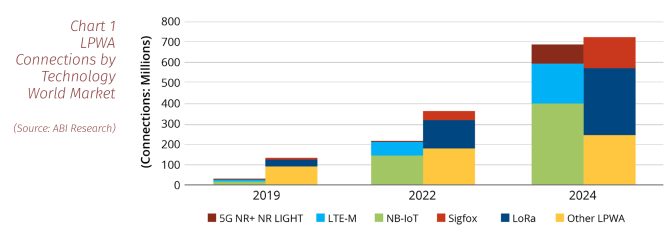
LoCreating global supply chain connectivity with multi-radio IoT
By Marc Pégulu, vice-president of IoT for Wireless & Sensing Products Group at Semtech
Automation / Robotics Electronics Wireless IoT asset Editor Pick IoT trackingFor tracking assets around the world or within facilities, smart sensors with tracking and tracing capabilities offer the global coverage needed to enable efficient and reliable monitoring.
As goods travel around the world, having visibility into their journey is important. But getting that visibility is not always easy. When cargo travels across land, sea, and sky, it also moves through different kinds of connectivity – and sometimes through hard to reach areas with no connection at all. When is the last time you tried to get a cellular signal in the middle of the ocean?
This is why multi-radio technologies are a game changer for asset tracking applications: they bring the interoperability needed to provide full transparency to the global supply chain. With advancements in asset management and geolocation technology, companies are now in a better position to harness smart solutions to improve their logistics management – knowing precisely the product lifecycle.
The world of massive IoT
The global Internet of Things (IoT) is made up of more than 14 billion connected devices, according to IoT Analytics. And that’s all types of connectivity. ABI Research estimates that the subset of IoT connected devices based on cellular IoT will reach 3 billion connections by 2026. Each of those devices represents a set of sensors that communicate over a set connectivity protocol.

Source: LoRaWAN and Multi-RAN Architecture Connecting the Next Billion IoT Devices
Each protocol is chosen based on the best-fit solution for that particular device. This includes short-range radios like Wi-Fi and Bluetooth, long range Low Power Wide Area Networks (LPWANs), and cellular technology like 5G. There are pros and cons to each connectivity solution: smart home devices often work on Wi-Fi and Bluetooth since they are typically affixed to a single location without the need for long-range or penetrating communication. This is in contrast to an application like equipping a commercial building with sensors, where an LPWAN can better penetrate through dense materials.
However, what some might not recognize is the way these networks can complement each other. Working in tandem, these networks fill connectivity gaps left between each connection’s strengths. For example, the open LoRaWAN network is license-exempt, setting it up to support massive IoT verticals like building automation, industrial metering, and asset tracking. Because of its low power nature, high bandwidth cellular networks complement LoRaWAN – providing the low latency needed to backhaul data.
Multi-radio capabilities
Multi-radio integration on individual devices means choosing the best attributes of multiple connectivity solutions all in one. By integrating more than one connectivity protocol onto a single device, multi-radio sensors are bridging previously disparate networks. For example, a multi-radio sensor brings together the low power, long range capabilities of an LPWAN and short-range wireless connectivity like Wi-Fi – enabling a device to communicate in more than one protocol.
When it comes to asset-tracking, multi-radio offers the opportunity to seamlessly track goods as they travel through geographies and settings. Specifically, with long range, low-power sensors and location data such as GNSS and network geolocation, trackers can be used in track and trace applications for data transmission frequency that ranges from every hour to less than every few minutes. Device-to-cloud geolocation services further reduce device hardware costs and optimize battery consumption, as they do not require an additional power source.
With these capabilities, sensors are transforming the way industries handle asset tracking, adding unparalleled value.
Continuous location tracking
Implementing sensors into the supply chain allows assets to be tracked throughout all points of the journey. Regardless of whether they are indoor or outdoor, on land or in the sky, the corresponding connectivity protocol picks up on location to provide visibility across the entire chain of custody.
Global geolocation services transform intercontinental supply chains. For example, imagine a car manufacturer in Europe is shipping new vehicles to North America. Before the shipment even leaves the continent, often it will travel through multiple service areas, requiring individual licenses to maintain connectivity. Then, once the shipment is loaded onto a cargo ship to travel across the ocean, all terrestrial network coverage is lost.
By combining a terrestrial LPWA network with a satellite network, the entire journey is tracked with no loss of connectivity – all enabled by using more than one radio protocol.
Increased efficiency
Traditional asset tracking approaches can be difficult to use. It is often complicated to set up and time-intensive to deploy, as it requires workers to physically monitor each asset onsite with little support. Implementing IoT solutions to monitor sensors remotely enables users to quickly locate and provide updates on the status of assets. This removes the manual labor required to find each asset in person, saving time, fuel, equipment, and resources.
Implementing multi-radio protocols can also save on deployment costs. Different kinds of network have a lot of variability in the cost it takes to establish the infrastructure. By using the more expensive connectivity networks only where necessary, and using widespread low-cost connectivity to cover the majority of ground, companies can largely offset infrastructure costs.
Sensors can also streamline their operations. With geolocation and GPS technologies, logistics managers can notably improve the asset tracking process for workers. The supply chain is more predictable since managers have visibility into progress, reducing the scramble for information. When an update on a shipment is needed, the information is already available. By eliminating random “fire drill” tasks, workers are able to work more productively and efficiently.
The impact of a more connected future
IoT sensors matched with reliable connectivity platforms provide accurate, real-time data visibility into asset tracking around the world. Including multi-band connectivity options on a single device, extends the simplicity and low-power advantages to more of the available wireless spectrum, thus improving the worldwide availability and coverage for IoT deployments.
For a global connectivity to be possible, interoperability across technology is key. Multi-band connectivity options support a future with ubiquitous, affordable and simplified IoT by providing the flexibility that the world needs to accelerate pervasive IoT adoption.
————————-

Marc Pégulu has been Semtech’s vice-president of Internet of Things for the Wireless and Sensing Products Group since 2019. Pégulu holds a Master of Science degree in Electronics and Telecommunications from Institut National Polytechnique of Grenoble, France and is a graduate of the Executive MBA program of ESCP Europe.
